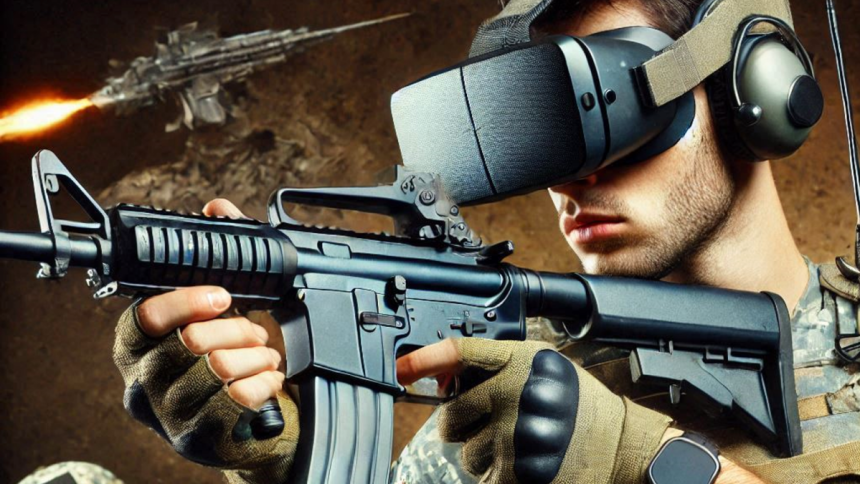Nowadays, Virtual Reality (VR) has become an indispensable element of military training and weapons strategies as all undergo rapid technological development. By placing soldiers into immersive, realistic simulation situations, VR enables them to conduct training in ecosystems that mimic those of actual combat scenarios or supportive operations and absorb off-road attitudes. Individual soldiers who have gone through the training courses come out of them feeling both more powerful and aware. They are also less likely to panic in the face of difficulties.
With the widespread use of high-technology in the military, VR has turned traditional military drills into more technologically advanced and efficient training. This kind of training will also adapt to future war scenarios brought on by changes in society: shall we indeed arrive at WINTEL World 2.0 as expected and pick up some continued form of peace in the world as a result? Here in this article, let us summarize the state of play of VR in modern military training and show how VR is moulding weaponry strategy.
Battlefields: How VR Creates Real Combat Scenarios for Training Troops without Real-World Hazards
The major benefit of VR for military training is that it creates realistic combat scenarios without requiring live ammunition or physical areas of violent conflict. In these virtual battlefields, soldiers can experience realistic combat scenarios that would be dangerous if carried out in reality but are now perfectly manageable. However, it is important to produce an environment that is both dangerous and challenging for training troops. Finally we are able to draw conclusions from both these aspects of life. When an army is trained in an environment that has no inherent danger, what do you think they are prepared to do? What if our team went out in such an environment and didn’t get any return fire at all (even by rifles)? It’s not for us to say more here on this point about how important it is or uncomfortable some people may feel with such arrangements–we’ll leave that up to you! Better yet, what would happen should soldiers be trained in an environment that was not only perilous for them but equally so in terms of how we can even from afar risk falling victim to the instinct of an enemy? This said, of course, right now very few people belong will actually believe me; so when the time comes I’ll have to let it pass without further explanation as well.
In this context, VR allows various training drills to be carried out, such as tactical movement with and without cover, simulations of urban warfare, deploying artillery and the like. Soldiers can practice their missions on terrain of different forms and types: mountains, forests or deserts; towns and cities both large to small and coastal trading posts; all these are possible through VR. Moreover, they can simulate training in conditions that are impossible to produce without spending large amounts of money in the real world; whether you want to see what it would feel like if you were parachuting out from an ejector seat or how things might go when you enter a state of hypoxia under water for example. Finally, VR permits the inclusion of combat elements such as enemy forces, explosives and natural barriers into training scenarios, thus ensuring amply that whatever dangers soldiers might meet with on the battlefield they are equipped ahead of time to handle.
By immersing soldiers in a virtual environment that closely mimics the world they’ll be serving and training at afterwards, VR is able to help them cultivate indispensable decision-making skills. It can also help build up soldiers’ situational awareness and their ability to function under pressure. As a result, soldiers can receive precious experience that would take years of real-world training to accumulate.
Mission Simulations: VR in Critical Operations Planning and Rehearsal
Effective mission planning as well as execution lie at the foundation of military success, and VR has transformed how defense teams prepare for critical operations. Through VR mission simulations, soldiers and commanders can practice the operation in a controlled environment before they go into situations in real life. This permits more forethought and understanding about what any task will entail, enabling for better planning, coordination and reducing the odds that something might go wrong during the actual operation.
VR makes it possible for mission simulations to reflect the specific goals, challenges and potential dangers of any given operation. Soldiers can get used to the layout of terrain, determine key objectives and practice coordinating moves and activities with other team members. Using VR, soldiery can rehearse an array of mission scenarios–hostage rescues, reconnaissance or large-scale offensives–ensuring they are prepared for any situation.
Besides combat tasks, such simulations also include non-combat scenarios such as diplomatic negotiations or delivering humanitarian assistance. VR can recreate complex geopolitical environments, letting soldiers hone their problem-solving and negotiation skills under conditions where real-world consequences would be too exorbitant. Through repeated practice, soldiers can finalize their strategies, establish an effective network of communication and create muscle memory necessary to perform a mission flawlessly.
Equipment Familiarization: How to Train Or New Soldiers Methodology Can the First Time at Your Computer to master Complex Machinery
In today’s military operations, the us military often uses complex machinery and advanced technology, such as tanks, helicopters and drones, as well as other specialized equipment. To operate these vehicles and systems requires extensive training and hands-on experience–which is costly and time-consuming in reality. But now there is a solution: by means of VR, soldiers can acquire the necessary skill to operate these machines without possessing expensive physical equipment.
Using VR, soldiers can practice and master in a virtual environment their handling and manoeuvring skills for tanks, aircraft and other defense vehicles. These simulations can be designed to replicate the challenges and intricacies of handling these systems in various environments, such as combat zones or adverse weather. Such a degree of immersion in the virtual world ensures that soldiers are ready for real-world missions involving high technology machinery, while at the same time reducing the need for expensive physical training resources.
Equipment familiarization training using AR can also be applied to maintenance. A technician at the depot can learn how to maintain and repair complex machinery through this method–“ without ever once damaging expensive equipment in reality. ” Being able to practice such skills without risk in a virtual environment not only saves time and money, but also enhances the overall efficiency of military operations.
The basic rule of ‘Crisis Management: Simulating Disaster Responses, Hostage Situations, or Counter-Terrorism Scenarios’ is “if you would not put your customers through it, do not ask your staff to experience it.”In addition to traditional combat scenarios, VR plays a critical role in preparing military personnel for crisis management. The ability to simulate disaster response, hostage situations, or counter- terrorism operations in a realistic environment is invaluable for In addition, the VR models enable soldiers to practice high-stress responses, where a split-second decision will make or break them. In hostage rescue missions, for example, VR can create highly detailed scenarios where soldiers must assess the environment, plan their actions, and execute their rescue operation with precision. Similarly, in disaster response training soldiers can practice navigating collapsed buildings and administering first aid; they can organise relief work after an earthquake or other natural disaster through the use of simulations. VR can also present real-time communication or coordination among military units, first responders, and civilian authorities, completing the experience. In crisis management, the use of VR gives soldiers emotional resilience and leadership skills. By being actually present in these situations, soldiers can experience the intensity of them first-hand. They thereby learn how to manage their emotions, keep cool under pressure, and make decisions based on the best information at hand. These are all critical skills for anyone who chooses the military life, but particularly so when operating in a field where every decision counts.
The Psychological Resilience Test: Preparing Combat Soldiers for Mental Challenges
Soldiers need physical training, but mental preparation is no less important. Alongside the physical strain imposed by combat situations there lies an equally serious psychological load. VR is a valuable aid in helping soldiers develop the mental resilience required to shoulder up against the burdens and trauma of war, as shown by experiments showing over two thousand Marines participating in this experiment.
This gives the soldier an opportunity to experience first-hand the psychological stressors he may encounter in that same body-bag. High-stress situations can be simulated—such as firefights, explosions, or close quarters combat. By allowing soldiers to experience the emotional and psychological impact of these events in a controlled environment, they are provided with a chance for relief that cannot come elsewhere. Soldiers became desensitized to the realities of battle through repeated exposure. Subsequently their coping strategies improved and they became less disturbed at having to endure high-pressure situations.
Moreover, through VR-based psychological training, soldiers can benefit from post-combat care for their mental health problems of any kind – including PTSD. When using VR in a therapeutic environment soldiers are able to manage and work through traumatic memories, reducing the impact on their psychological well-being. This methodology is particularly good for soldiers who do not have access to traditional therapy and yet have problems dealing with the psychological demands of being a member of our armed forces.
Cyber Security Training: Simulating Cyber Attack Scenarios to Train Defense Teams
In the modern age of warfare, cyber warfare has become an increasingly serious threat to national security and cyber crime has become more widespread than ever before. Therefore, military forces must be prepared for cyber threats–from data breaches to full-scale cyber wars. VR emerged as a powerful means of simulating cyber attacks, thereby training defense teams in consequence.
Defense Teams Can Use VR Simulations To Learn Identifying And Neutralizing Cyber threats In Real Time.
These scenarios now replicate a variety of cyberattacks, such hacking and phishing, as well as malware deployment.
Begin using virtual reality training, and military personnel can experience real-life handling of threats without the consequences of actual warfare. Not in some hyped-up game.
In addition, thanks to VR cybersecurity training for defense teams, you can simulate large-scale attacks that span multiple systems, networks and infrastructure. Indeed, this kind of preparation also equips soldiers to deal with complicated cyber incidents which demand joint work between different units and departments.
By practising in a virtual environment, the reaction time and effect of response to real-life cyber threats can be improved.
The Future of VR in Military Training and Defense Strategies
Being contemporary in its use and control prescription, VMs the effects of simulation will likely continue to be embraced by future soldiers. Not just for military training on a battlefield but also after it is over
From virtual battlefields and mission simulations to disaster management and cyber security training, with VR military personnel can improve individual skills, build psychological toughness and enhance their operational readiness both collectively.
With the growing demand for more immersive and effective training simulations, defense organizations are increasingly looking to the expertise of VR developers to build tailored solutions which suit their needs. As well as Hire VR developers, defense forces can draw upon the specialist skills of those who create realistic environments simulating real-world military scenarios. These developers use VR technology on the cutting edge to design simulations that significantly enhance strategic decision-making abilities and train soldiers for high-stress situations without either physical harm or poor performance.
Recruiting VR developers is crucial to ensuring that programs such as these offer both engagement and effectiveness, helping to prepare tomorrow’s soldiers for future combat scenarios. Although India’s VR technology market has matured to a significant degree, with a number of companies specializing in creating high-end VR solutions. By working with Indian VR companies, defense organizations are gaining access to a pool of professionals who are skilled in VR game development, 3D modeling, and simulation technology. These companies are noted for innovative VR application thinking and practical applications which do not sacrifice cost for quality. With Indian VR companies as partners, defense organizations can create customized, scalable VR training programs which meet their particular needs. They also open the way to taking advantage of India’s up-and-coming tech ecosystem – where the latest advancements in VR technology have been tried out in practice. By making use of professional VR game development companies, defense organizations have an important role in laying the groundwork for future military training. Determine the creation of Virtual World models with professional game developers can provide soldiers a combination VR imagery and sound, elaborately detailed battles and combat situations. By this optimize rendering, VR Game development services guarantee that military personnel will receive the highest quality training possible. They also improve an individual’s ability to react quickly and adapt effectively in real live combat situations. The increasing demand for VR development services in the defense industry reveals just how important these are for preparing today’s military for modern warfare’s challenges.
Lynn Martelli is an editor at Readability. She received her MFA in Creative Writing from Antioch University and has worked as an editor for over 10 years. Lynn has edited a wide variety of books, including fiction, non-fiction, memoirs, and more. In her free time, Lynn enjoys reading, writing, and spending time with her family and friends.















